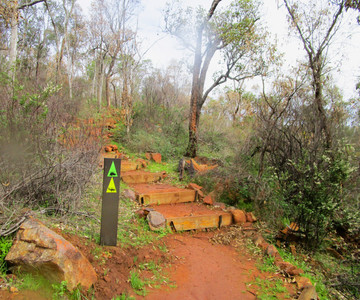
Paruna was chosen as a safe haven for wildlife because of it's location between two national parks, Avon Valley National Park and Walyunga National Park. Just getting here is an adventure as you wind your way around the hairpin bends and winding curves on O'Brien Road, itself a designated Flora Road.
Public access to Paruna Wildlife Sanctuary is restricted to the cooler months from 1 May through to 31 October. Bookings must be made in advance through their website as an $11 per person entry fee is payable and you require a unique access code - refreshed daily - to enter.
There are three trails within Paruna - the 2.3km Possum Loop, the 6.5 km Quenda Circuit and the 12km Numbat Trail which incorporates the Quenda Circuit with an additional tadpole loop trail. The trails here are well maintained but the terrain is steep and Paruna is renowned for it's many stairs - up to 1000 on the Numbat Trail! We opted for the Quenda Circuit for our first experience to gauge the difficulty of the terrain and to assess the time required for the longer hike. It is recommended to hike the trails in an anti-clockwise direction. Trail markers are located at junctions along the trail and trail notes describing the landscape, flora and fauna can be downloaded from the Paruna Wildlife Sanctuary website.

The Quenda Circuit on it's own is a very rewarding hike with a variety of terrain and landscapes including creeks and stunning views along the Avon Valley. As you set off you pass through wandoo and powderbark woodland to the west of the dam, crossing the creek along a boardwalk in between granite boulders. We could hear and see beautiful red tailed cockatoos as we skirted a second dam, continuing to follow the creek line. Through dense forest we could see steps on the red dirt trail climbing the other side of the valley.
The trail soon split with Possum Loop veering off to the left. We wandered the short distance down to the boardwalk to watch the water gushing down the creek before returning to Quenda Circuit.
There is a spur trail 1.4km along leading to a lookout with stunning views to the west. You then pass some massive Powderbarks, one with a series of burls (growths) on it's trunk.
Another side trail heads a short way uphill to another bench before the trail descends to a picnic table with stunning views of the Avon River Valley. Unfortunately rain showers were moving in and the cloud cover was quite low.
The descent continues with a series of switchbacks down the steep hill. As we were heading down the hill through the drizzle we could see some 4WD vehicles negotiating the steep fire trail on the opposite side of the valley on a training exercise. The trail crosses Paruna Creek to a viewing platform overlooking the creek as it flows into Paruna Gorge. This is the most scenic spot and this was also when the rain was heaviest!
The trail continues to climb to another short boardwalk leading to another viewing platform - this time the rain has cleared.
At the 4km mark the trail comes around a sharp rocky point with a stream below and a massive exposed granite slab on the valley across to the south. Keep an eye out here for wedge tailed eagles riding the thermals.
The trail follows alongside a vehicle track before crossing a creek. Here, after sharing just over 4km with the Quenda Circuit, the Numbat Trail peels off to the right for a 5.4km tadpole loop. If you were considering hiking the Numbat Trail this is a good point to re-assess! The Quenda Circuit continues on, climbing steeply via a series of switchbacks. There is a marked 100m side trail to the John Forrest Cairn Monument. This cairn was built in 1879 during the original survey trip through the valley. Hiking through this pristine bush environment one has to wonder what those early explorers were thinking!
The trail follows the ridge with fantastic Avon Valley views before turning away from the valley, descending some stone steps into another type of landscape.
The Possum Loop re-joins the trail as it climbs once again through wandoo and powderbark woodland leading on to a wider vehicle track for a short distance before opening out onto a massive granite outcrop called Pink Rock for the verticordia that covers the area in pink flowers during late spring. Another boardwalk crosses this rock to a final viewing platform with a spectacular view encompassing the Avon River in the centre and the Brockman River to the north with the vibrant green pastures of Chittering in between.
The trail follows the vermin proof fence as it heads down to the entrance gate area. It took us 3 hours to hike this trail. We were slower than other hikers who overtook us but 3 hours is probably realistic if you stop at the viewing platforms and take it all in.

At the very end of August we were rewarded with plenty of water in the creeks but not so many wildflowers. There were splashes of yellow verticordia, sundews and many of the little purple flowers along with early parrot bush, hibbertias, wattle and a sprinkling of pink fairy orchids.
Paruna is very remote and phone signal is unreliable. Come prepared with sturdy shoes, a hat, sunscreen, insect repellent, wet weather gear, a first aid kit, snacks and 2-3 litres of water per person. Please pack everything back out with you (including tissues) as there are no rubbish bins. Benches and picnic tables are located along the trail and also near the dam at the entrance gate. A very clean and well maintained composting toilet is available inside the gates.

Other trails in this area are Lake Leschenaultia, Noble Falls, FR Berry Reserve, Bells Rapids and Walyunga National Park walks.
To read more blogs go to:
I love wandering along trails, both marked and unmarked, and sharing my discoveries with my Out and About FNC community. If you enjoy reading my blogs please consider a small donation which will be used towards the costs of keeping the website up to date and relevant.

In the spirit of reconciliation Out and About- Family Nature Connection acknowledges the traditional owners of the Wadjak Boodjar (Perth land) and their connections to land, sea and community. We pay our respect to their elders past and present and emerging and extend that respect to all Aboriginal and Torres Strait Islander peoples today.
As always when hiking in the bush please help to reduce the spread of Phytophthora Dieback by sticking to the tracks and paths, staying out of quarantined areas and, if possible, clean your shoes before and after hiking. A spray of 70% methylated spirit and 30% water can be effective.






















































































Comments